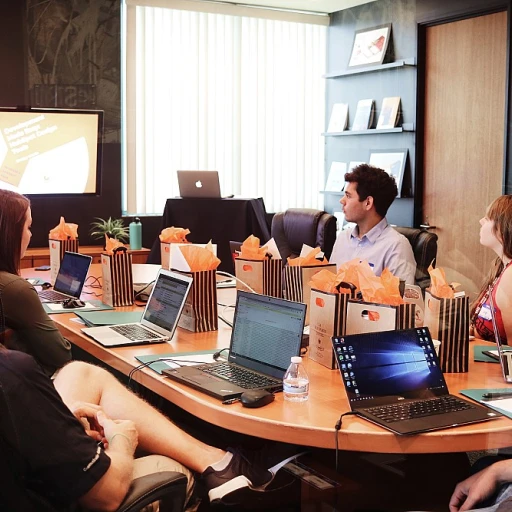
Understanding Competency Management
Grasping the Fundamentals of Competency Dynamics
In the swiftly evolving landscape of modern business, understanding the dynamics of competency management is imperative for organizations seeking to bridge skill gaps and enhance workforce agility. The concept revolves around identifying, managing, and developing the essential skills and capabilities that employees must possess to meet business goals effectively.
Competency management begins with a clear strategy that aligns with the organization's objectives. It involves a meticulous process of evaluating and defining the competencies required for various job roles. This is where the competency model comes into play – a structured framework that simplifies competency development by categorizing skills based on their relevance and necessity for certain positions.
Effective competency management facilitates the creation of a tailored training approach, empowering management to focus on targeted learning development that enhances employee performance. Employing a solid management process ensures that talent management aligns seamlessly with the competency framework, optimizing performance management.
To stay competitive, businesses leverage sophisticated management software that aids in competency tracking and analysis. Such management systems help in performing comprehensive gap analysis, pinpointing areas where the workforce can benefit from reskilling initiatives.
With these insights into competency management, organizations can strategize on how to build and nurture the right skill sets, paving the way for a more competent and adaptable workforce. This approach ensures that employees are not only job-ready but also future-ready in an ever-changing business environment.
Identifying Key Competencies for Reskilling
Pinpointing Crucial Skills and Capabilities for Effective Reskilling
Identifying key competencies is a significant step in the reskilling journey as it forms the foundation for tailored training and development initiatives. By zeroing in on these essential skills, organizations can effectively bridge employee performance gaps.- Competency Models: Leveraging a competency model is crucial in this process. These models help outline critical job roles and the specific skills needed to meet business goals. A competency framework not only delineates core competencies but also aligns them with organizational needs.
- Skill Gaps Analysis: Conducting a gap analysis helps organizations understand where skill shortages exist. Identifying these gaps is essential for competency management, allowing for targeted employee development and learning opportunities.
- Technology Integration: Competency management software assists in monitoring and assessing employee performance. These tools streamline the management process by organizing competencies and identifying areas for improvement.
Developing a Competency Framework
Building a Solid Competency Framework
A competency framework is an essential tool for organizations aiming to maximize the effectiveness of their reskilling efforts. Its creation requires a structured approach, focusing on identifying, organizing, and utilizing the skills and competencies necessary for employee development and achieving business goals effectively. To start with, understanding the specific competencies that support the organization's objectives is crucial. By conducting a gap analysis, organizations can identify the skill gaps within their workforce, which serve as a foundation for the competency development process. This analysis helps in recognizing the core competencies that are vital for business success and employee performance. Once these competencies are identified, the next step involves organizing them into a competency model. This model acts as a framework that categorizes skills and abilities relevant to different job roles within the organization. It aids in competency-based learning development, enabling employees to align their training with the organization's goals. Integrating technology is crucial in implementing an effective framework. Competency management software allows organizations to streamline the management process, track employee progress, and ensure that learning development is aligned with the identified competencies. Such systems are part of a talent management strategy that enables organizations to efficiently manage their workforce capabilities and address skill gaps. An effective competency management framework also requires continuous monitoring and updates. As business goals evolve, so should the competency framework to ensure it remains relevant. The use of a performance management system can facilitate regular reviews and updates, ensuring that employees continue to develop relevant skills that boost their performance and support the organization's long-term objectives. Creating a competency framework is not just about organizing and categorizing skills; it influences how organizations manage their talent, aligning training programs with strategic objectives. This structured approach not only improves employee performance but also strengthens the organization's capability to meet future challenges. For further insights into understanding skill levels for effective reskilling, visit Understanding Skill Levels in Reskilling.Integrating Technology in Competency Management
Leveraging Technology for Enhanced Competency Management
In today's fast-paced business environment, integrating technology into competency management is not just an option; it's a necessity. Organizations are increasingly relying on advanced tools to streamline the management process, ensuring that their workforce is equipped with the necessary skills to meet evolving business goals.
Technology plays a crucial role in identifying and bridging skill gaps. Competency management software, for instance, allows organizations to conduct comprehensive gap analysis, helping them pinpoint areas where employees need further development. This targeted approach ensures that training efforts are aligned with the organization's core competencies and strategic objectives.
Enhancing Employee Performance with Management Systems
Management systems equipped with robust competency models facilitate continuous learning and development. These systems provide employees with personalized learning paths, enabling them to acquire new skills and improve their performance. By fostering a culture of continuous improvement, organizations can enhance their talent management strategies and ensure that their workforce remains competitive.
Moreover, integrating technology into competency management supports performance management by providing real-time data on employee progress. This data-driven approach allows managers to make informed decisions about talent development and succession planning, ultimately contributing to the organization's long-term success.
Overcoming Challenges with Technology
While technology offers numerous benefits, it also presents challenges that organizations must address. Implementing new systems requires careful planning and change management to ensure a smooth transition. Organizations must also invest in training their employees to use these tools effectively, maximizing the return on investment.
Despite these challenges, the benefits of integrating technology into competency management far outweigh the drawbacks. By leveraging the right tools, organizations can enhance their capability to manage competencies effectively, ensuring that their workforce is prepared to meet future demands.
Overcoming Challenges in Reskilling
Addressing the Hurdles in Reskilling
Reskilling is a strategic necessity for organizations aiming to stay competitive in today’s rapidly evolving business landscape. However, the journey is not without its challenges. Understanding these obstacles is crucial for effective competency management and ensuring that reskilling initiatives lead to meaningful employee development and improved performance.
Identifying Skill Gaps
One of the primary challenges in reskilling is accurately identifying skill gaps within the workforce. This requires a comprehensive gap analysis to determine where employees’ current competencies fall short of the organization’s business goals. A well-defined competency model can aid in this process, providing a clear framework for assessing existing skills against desired capabilities.
Aligning with Business Goals
Ensuring that reskilling efforts align with the organization’s strategic objectives is another critical challenge. Competency management systems must be integrated with talent management and performance management processes to ensure that training and development initiatives are not only relevant but also contribute to the organization’s overall success. This alignment helps in creating a workforce that is not only skilled but also agile and capable of adapting to new job roles as needed.
Leveraging Technology
Integrating technology into competency management can streamline the reskilling process, but it also presents its own set of challenges. Organizations must select the right management software that supports their competency framework and facilitates efficient learning development. The right technology can enhance the management process by providing data-driven insights into employee performance and competency development.
Ensuring Employee Engagement
Employee engagement is crucial for the success of any reskilling initiative. Organizations must foster a culture of continuous learning and development, encouraging employees to take ownership of their career growth. This involves creating a supportive environment where employees feel motivated to enhance their skills and embrace new competencies.
Managing Change
Finally, managing change effectively is essential to overcoming challenges in reskilling. Organizations must communicate the benefits of reskilling clearly and consistently, ensuring that employees understand how these efforts will enhance their job security and career prospects. By cultivating an enterprise mindset, businesses can navigate the complexities of reskilling and build a resilient, future-ready workforce.
Measuring the Impact of Reskilling through Competency Management
Evaluating Reskilling Success Through Competency-Based Metrics
Measuring the impact of reskilling programs is crucial for organizations aiming to enhance their workforce competencies and align with business goals. An effective way to assess this impact is by employing competency-based metrics integrated within the competency management process. This approach ensures that skill gaps are addressed and employee performance is enhanced. A thorough analysis involves several key steps:- Performance Management Systems: Implementing advanced performance management systems can provide valuable insights into employee progress. By tracking individual performance against defined core competencies, organizations can identify improvements in job roles and overall workforce capability.
- Competency Frameworks and Models: Utilizing a well-developed competency framework allows businesses to create a structured approach to evaluate skill development. This framework serves as a benchmark for assessing how effectively employees have acquired new skills and closed competency gaps.
- Technology Integration: Leveraging competency management software can streamline this evaluation process. With the right tools in place, organizations can efficiently gather data on employee learning and development, enabling a more accurate analysis of training effectiveness.
- Feedback Mechanisms: Incorporating regular feedback sessions empowers employees to express their experiences and challenges. This feedback provides qualitative data that complements quantitative metrics, offering a comprehensive view of the reskilling initiative's impact.













